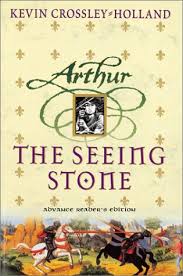 Rebecca Swain penned this review.
Rebecca Swain penned this review.
I found this novel for children aged 9-12 delightful and informative. It is the story of Arthur de Caldicot, a curious, ambitious young boy growing up in medieval England, near the Welsh border. Arthur has a mean older brother, a Welsh mother and grandmother, a stern but loving father who has some plan for him that Arthur can’t quite figure out, and a handful of other siblings.
Arthur also has a rather mysterious friend, Merlin, who never speaks of his past. One day Merlin gives Arthur a piece of obsidian and tells him it will be the most precious thing he will ever own. Arthur doesn’t understand why until one day he looks into the reflective black surface of the stone — and sees a peculiar scene of men digging a pit, and two dragons fighting at the feet of a king.
Of course he is seeing events from the legend of King Arthur, though he doesn’t realize this at first. Over time he sees more and more of the happenings at Arthur’s court, and has adventures of his own besides.
The charm of this book is not so much in the Arthurian aspect: there are thousands of novels dealing with the legend of King Arthur in some way. The marvelous thing about this novel is Crossley-Holland’s ability to convincingly create Arthur de Caldicot’s life in a little castle on the Welsh border at the beginning of the thirteenth century.
Crossley-Holland provides numerous details that add verisimilitude to his setting: worms (“squirms”) in the cheese; making mittens out of cat’s fur; infant mortality. But instead of digressing from the story to give us long explanatory passages about the customs and circumstances of the day, the author simply incorporates them into the plot and dialogue. Arthur and other characters observe these aspects of daily life without explanation, as you or I would comment on flipping a light switch without describing how it works.
The novel is divided into many short chapters, some less than a page long. Not all of them directly move the plot. For example, one chapter, “The Messenger’s Complaint,” deals with the severe case of diarrhea King John’s messenger gets from eating the unfamiliar food of the March (the Welsh border). While this incident does nothing much for the plot, it helps establish character and illustrate common attitudes of the time. The book is full of such effective little touches.
There is also a great deal of dialogue, which makes the book a quick and compelling read despite its almost 350 pages.
I recommend this book for any junior high student looking for an interesting read, and I’m sure many adults will enjoy it as well.
(Scholastic Press, 2000)
